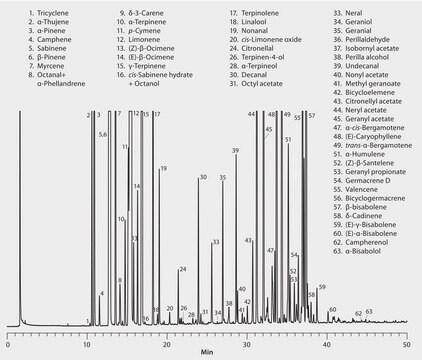40147-U
C8-C40 Alkanes Calibration Standard
in dichloromethane (varied)
About This Item
Productos recomendados
CofA
current certificate can be downloaded
envase
pkg of 1 mL
concentración
in dichloromethane (varied)
técnicas
HPLC: suitable
gas chromatography (GC): suitable
aplicaciones
petroleum
Formato
multi-component solution
temp. de almacenamiento
2-8°C
Categorías relacionadas
Aplicación
Otras notas
Analito
Palabra de señalización
Warning
Frases de peligro
Consejos de prudencia
Clasificaciones de peligro
Carc. 2 - Eye Irrit. 2 - Skin Irrit. 2 - STOT RE 2 - STOT SE 3
Órganos de actuación
Central nervous system
Código de clase de almacenamiento
6.1D - Non-combustible, acute toxic Cat.3 / toxic hazardous materials or hazardous materials causing chronic effects
Clase de riesgo para el agua (WGK)
WGK 2
Punto de inflamabilidad (°F)
Not applicable
Punto de inflamabilidad (°C)
Not applicable
Listados normativos
Los listados normativos se proporcionan para los productos químicos principalmente. Para los productos no químicos sólo se puede proporcionar información limitada. Si no hay ninguna entrada, significa que ninguno de los componentes está en la lista. Es obligación del usuario garantizar el uso seguro y legal del producto.
EU REACH Annex XVII (Restriction List)
Elija entre una de las versiones más recientes:
¿Ya tiene este producto?
Encuentre la documentación para los productos que ha comprado recientemente en la Biblioteca de documentos.
Los clientes también vieron
Nuestro equipo de científicos tiene experiencia en todas las áreas de investigación: Ciencias de la vida, Ciencia de los materiales, Síntesis química, Cromatografía, Analítica y muchas otras.
Póngase en contacto con el Servicio técnico



